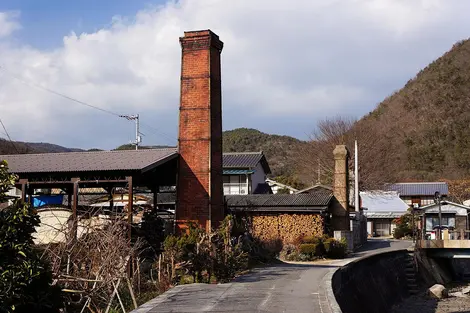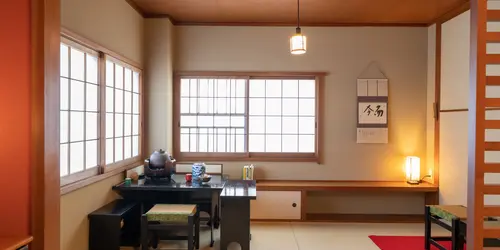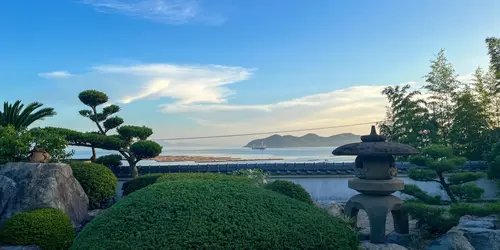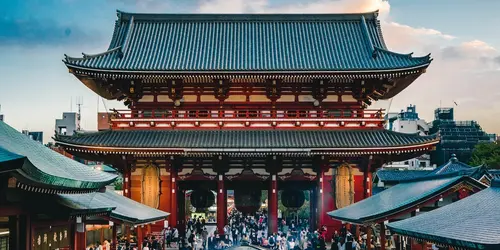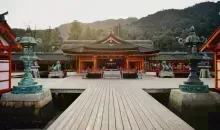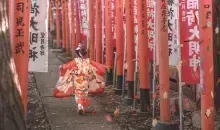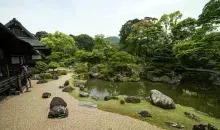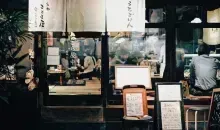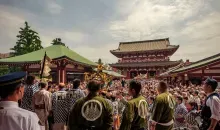Bizen ceramics
- Published on : 03/07/2018
- by : C.L
- Youtube
Age-old craftsmanship
Bizen ceramics (備前焼, Bizen-yaki) are one of Japan's most emblematic artistic treasures. Originating in Okayama Prefecture, this age-old tradition fascinates with its raw, natural beauty. Each piece tells a unique story, shaped by clay, fire and the skills of master potters. Renowned for its characteristic ochre and earth tones, Bizen ceramics represent the very essence of Japanese aesthetics. With no artificial glaze, these creations derive their beauty from the interaction between iron-rich earth and kiln flames. Let's plunge together into the fascinating world of this exceptional craft, which continues to captivate collectors and art lovers the world over.
History and origins of Bizen ceramics
The history of Bizen ceramics goes back over 1000 years. Originating in Bizen province, in today's Okayama prefecture, this ceramic tradition is one of the oldest in Japan. The first traces of production date back to the Heian period (794-1185), but it was during the Kamakura period (1185-1333) that Bizen became one of Japan's six historical centers of ceramic production (Rokkoyo).
During the Muromachi period (1336-1573), Bizen pottery gained in popularity thanks to the exceptional quality of its clay and its remarkable strength. The use of local hiyose clay, particularly rich in iron, enabled the creation of robust pieces with characteristic reddish hues. This period marked the definition of Bizen's distinctive style, which continues to this day.
However, it was during the Momoyama period (1573-1603) that Bizen ceramics experienced their golden age. Toyotomi Hideyoshi, a powerful warlord, and Sen no Rikyū, the famous tea ceremony master, were particularly enamored of the Bizen style. This recognition contributed to the spectacular growth of Bizen ceramics. During this period, an impressive kiln 50 meters long and 5 meters wide was built, testifying to the importance of this production.
During the Edo period (1603-1868), production slowed down somewhat, but Lord Ikeda Mitsumasa commissioned the construction of the Shizutani School, now classified as a national treasure, whose tiles are made from Bizen ceramics. This prestigious commission testifies to the value placed on this craft. During the Meiji era (1868-1912), interest in traditional ceramics waned considerably, and only a few small potters' kilns remained in Bizen.
Unique features of Bizen ceramics
Bizen ceramics are distinguished by several features that make them unique in the world. Perhaps its most remarkable feature is the total absence of artificial glaze. Unlike most other ceramics, Bizen pieces are not covered with a colored glaze. It's the clay itself, naturally rich in iron, that gives them their characteristic hues ranging from ochre to deep reddish-brown.
The manufacturing process begins with the meticulous preparation of local clay. This special clay, called hiyose clay, is ground, soaked in water, drained and trampled. It is then kneaded using a traditional technique called "kikuneri" (kneading in the shape of a chrysanthemum flower), which eliminates air bubbles. Each piece is shaped by hand or on a lathe, demonstrating the skill of craftsmen who perpetuate techniques handed down from generation to generation.
Firing is the crucial step that gives Bizen ceramics their distinctive character. Pieces are fired in traditional kilns known as noborigama (staircase kilns) at temperatures approaching 1300°C over an extraordinarily long period, from one to several weeks. These kilns are fired exclusively with red pine wood (Akamatsu), whose ashes and flames interact directly with the clay.
This firing method creates fascinating and unpredictable aesthetic effects. The fly ash settles on the pieces and melts on contact with the heat, forming natural patterns and a unique texture. The arrangement of the pieces in the kiln, the intensity of the fire and the quality of the ash are all factors that influence the final appearance. This is why each Bizen piece is absolutely unique, bearing the traces of its encounter with fire, as a testimony to the dialogue between matter and the elements.
The wabi-sabi philosophy and its influence on Bizen pottery
Bizen ceramics are deeply rooted in wabi-sabi philosophy, a Japanese aesthetic concept that celebrates the beauty of imperfection, impermanence and incompleteness. Wabi-sabi is not simply an artistic style, but a true worldview that influences every aspect of Japanese culture, from architecture to pottery to the tea ceremony.
The term "wabi-sabi" combines two distinct concepts. Wabi (侘) emerged in the 15th century to describe a new aesthetic associated with solitude or melancholy, and a serene life far from urban bustle. It evokes a refinement nourished by simplicity, understated elegance and unsophisticated nobility. Sabi (寂) dates back to the 8th century and was originally a poetic term for desolation. From the 12th century onwards, it came to characterize the delightful contemplation of what is old and worn, the beauty of things faded or withered.
An emblematic legend perfectly illustrates the essence of wabi-sabi in the art of pottery. The young Sen no Rikyū, eager to learn the codes of the tea ceremony, visited a renowned master named Takeeno Joo. The latter wanted to test his new apprentice's abilities and asked him to look after the garden. Rikyū cleaned and raked the garden until it was perfect. However, before presenting his work to his master, he shook a cherry tree so that a few blossoms fell to the ground. This deliberate touch of imperfection brought a natural beauty to the scene, perfectly illustrating the concept of wabi-sabi.
Bizen ceramics ideally embody this philosophy. Its irregularities, rough textures and unpredictable patterns created by the fire are precisely what make it so beautiful. Bizen potters don't aim to create perfectly uniform pieces - they embrace the accidents of firing and transform them into aesthetic qualities. As Andrew Juniper explains in his book "Wabi Sabi: The Japanese Art of Impermanence", wabi-sabi represents"an intuitive appreciation of ephemeral beauty in the physical world that reflects the irreversible flow of life". This philosophy is at the very heart of Bizen's ceramics, which gain in character and beauty with time and use.
The traditional techniques and motifs of Bizen ceramics
Bizen ceramics are distinguished by a variety of techniques and patterns that result directly from the unique firing process. Without resorting to painting or engraving, Bizen potters achieve fascinating decorative effects through the strategic placement of pieces in the kiln and the interaction of flames, ash and clay.
One of the most iconic motifs is the hidasuki (緋襷), which literally translates as "scarlet scarf". To create this effect, potters wrap the pieces in rice straw before firing. As the kiln heats, a chemical reaction occurs between the iron in the clay and the straw, creating distinctive patterns of bright red "flames" that appear to dance across the surface of the ceramic. What was probably originally a happy accident has become a sought-after technique characteristic of the Bizen tradition.
Another remarkable effect is goma (胡麻), which literally means "sesame seeds". This pattern occurs when pine ashes fly into the kiln and settle on the surface of the clay, creating small flecks of natural glaze. The intense heat melts these deposits, producing a bright, sometimes granular ochre decoration that scatters the surface like sesame seeds. When these ash deposits are more extensive and form drips, we speak of tamadare.
Sangiri (桟切り) is a more mysterious and complex effect that occurs during reduction firing. When the airflow is partially blocked and embers fall onto the pieces, a chemical reaction between the iron in the clay and the carbon in the embers generates hues ranging from white to blue and slate-gray. These subtle and unexpected nuances add an extra dimension to the natural palette of Bizen ceramics.
Other techniques include botamochi (牡丹餅), named after a traditional Japanese pastry. This effect is achieved by placing small round plates on top of larger ones to protect them from flying ash, creating distinct circular patterns. Fuseyaki results from stacking the pieces on top of each other during baking, producing protected areas that color differently. The rare aobizen or "blue bizen" is only possible when the pieces are fired in an oxygen-poor atmosphere, creating a cloud of gas around the ceramic in the kiln.
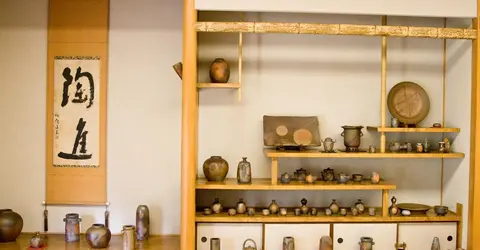
Bizen ceramics
jaro
Bizen ceramics in the Japanese tea ceremony
The relationship between Bizen ceramics and the Japanese tea ceremony is profound and historically significant. It was in the 16th century that Bizen pottery gained a privileged place in this ritual art, thanks in particular to the influence of Sen no Rikyū (1522-1591), the most important figure in the history of the Japanese tea ceremony.
Sen no Rikyū revolutionized the practice of chanoyu (the way of tea) by emphasizing simplicity and naturalness over ostentation. Before his influence, the utensils used for the tea ceremony were often precious, ornate pieces imported from China. Rikyū, in search of a more sober aesthetic reflecting the principles of wabi-sabi, turned to traditional Japanese pottery, including Bizen. The raw look, irregular texture and earthy colors of these ceramics perfectly matched his vision of a tea ceremony imbued with simplicity and authenticity.
Bizen tea bowls, known as chawan, are particularly appreciated for their ability to keep tea hot for longer, thanks to the thickness and density of the clay. Their rough texture offers a pleasant tactile experience and their natural appearance, with no artificial decoration, allows you to concentrate on the very essence of the ritual. What's more, the iron in Bizen clay is said to subtly enhance the flavor of the tea, adding an extra dimension to the taste experience.
The tea ceremony style influenced by Sen no Rikyū, also known as wabi-cha, uses imperfect objects, sometimes broken and repaired, in a space devoid of superfluous ornamentation. This approach transforms tea drinking into a true spiritual communion, nourished by the principles of harmony (wa), respect (kei), purity (sei) and tranquility (jaku). Even today, the most prestigious tea ceremonies use ancient teacups, some hundreds of years old, and traditional utensils whose imperfection is valued as an aesthetic quality.
Where to discover and appreciate Bizen ceramics
For art lovers and the curious who wish to discover Bizen ceramics, several destinations in Japan offer an authentic immersion in this artistic universe. The town of Bizen itself, located in Okayama prefecture west of Kobe, is the ideal starting point for this exploration.
Bizen's Imbe district is the historic heart of this ceramic tradition. This potters' village is home to around a hundred workshops and galleries where craftsmen still work according to ancestral methods. As you stroll through its picturesque lanes, you can see the distinctive red-brick chimneys of the traditional kilns and visit various stores offering a wide range of creations. Workshops such as Hozangama, run by Toshiyaki Mori, a direct descendant of the original six Bizen-yaki pottery families, perpetuate this exceptional know-how.
For a more educational approach, the Fujiwara Kei Art Museum exhibits some 250 objects, both ancient and contemporary, offering a comprehensive overview of the evolution of this art through the centuries. The museum also organizes workshops where visitors can learn how to create Bizen ceramics. The Maison de la Céramique de Bizen is another not-to-be-missed venue, showcasing the work of contemporary potters who are renewing the tradition while respecting its foundations.
If you can't make it to Bizen, other museums in Japan offer notable collections of Bizen ceramics. The Museum of Oriental Ceramics in Osaka boasts a remarkable collection of traditional Japanese ceramics, including many Bizen pieces. In Tokyo, the National Museum also houses an important collection dedicated to Japanese ceramic arts.
For the more passionate, the Bizen Ceramics Fair, held every year on the third weekend in October, is a major event that attracts collectors and enthusiasts from all over the world. It's the ideal opportunity to meet craftsmen, attend demonstrations and perhaps acquire some unique pieces.
As you explore the richness of Japanese ceramics, don't forget to visit other historic centers too, such as the Okawachiyama potters' village or Tokoname, the city of earth, which offer complementary perspectives on the diversity of Japanese ceramic traditions.
How to integrate Bizen ceramics into your everyday life
Integrating Bizen ceramics into your daily life means surrounding yourself with objects that combine functional beauty with philosophical depth. These handcrafted pieces are not simply decorative objects, but living creations that enrich every moment with their authentic presence and their connection to an age-old tradition.
The table is undoubtedly the most natural place to introduce Bizen ceramics into your everyday life. Bizen-yaki bowls, plates and dishes bring a unique tactile and visual dimension to meals. Their earthy hues and varied textures create a striking contrast with food, highlighting the colors and shapes of your kitchen. Unlike standardized industrial tableware, each Bizen piece has its own character, making every meal more personal and memorable.
For beverage lovers, Bizen's ceramic yunomi teacups offer an incomparable sensory experience. The iron in Bizen clay is said to enhance the taste and aroma of tea. These cups, often deformed and irregular, perfectly embody the wabi-sabi aesthetic, transforming the simple act of drinking into a moment of contemplation. Similarly, Bizen sake sets, comprising a bottle (tokkuri) and small cups (guinomi), allow you to enjoy this traditional Japanese beverage in an authentic context.
For beer lovers, Bizen clay mugs are a refreshing alternative to conventional glasses. The texture of the clay and its ability to maintain a cool temperature enhance the tasting experience. Serving beer in a Bizen ceramic mug completely changes the tasting experience, as the iron in the clay subtly enhances the beverage's aromas.
Beyond the table, a Bizen ceramic vase can become the focal point of a space. Its raw, natural beauty particularly enhances simple floral arrangements or ikebana compositions. A simple branch or solitary flower in a Bizen vase creates a moment of visual poetry that embodies the spirit of wabi-sabi.
If you'd like to acquire authentic Bizen ceramics, there are several options open to you. While traveling in Japan, you can visit the Bizen workshops directly to purchase pieces directly from the artisans. To choose and buy ceramics in Japan, nothing beats direct contact with the creators. If this isn't possible, galleries specializing in Japanese art or online boutiques also offer selections of Bizen ceramics. Whatever your approach, every Bizen piece you integrate into your daily life brings with it a part of Japan's soul and history, enriching your surroundings with authentic, timeless beauty.
Address, timetable & access
Address
Timetable
about 4 hours from Tokyo by Shinkansen to Okayama then take a local train on the Ako line to Imbe station.Access
Approx. 4 hours from Tokyo by Shinkansen to Okayama, then take a local Ako train to Imbe station.


